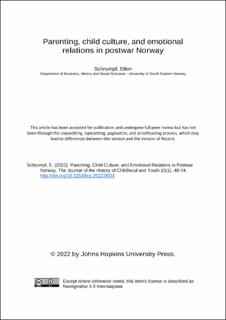Parenting, child culture, and emotional relations in postwar Norway
Journal article, Peer reviewed
Accepted version
Permanent lenke
https://hdl.handle.net/11250/3053192Utgivelsesdato
2022Metadata
Vis full innførselSamlinger
Originalversjon
Schrumpf, E. (2022). Parenting, Child Culture, and Emotional Relations in Postwar Norway. The Journal of the History of Childhood and Youth 15(1), 48-74. http://doi.org/10.1353/hcy.2022.0003Sammendrag
In Norwegian history, the decade of the 1950s is described as children's "happy decennium." These were the years of optimism and promising prospects as well as the establishment of the Norwegian welfare state. This article is based on interviews about growing up in postwar Norway. According to the interviews, a primary parenting strategy at that time was to send the children outdoors and let them manage themselves. Children were unsurveilled in these years like neither before nor after. Postwar Norway was a specific child culture's classic years. Children were entrusted to neighborhoods and streets, where they learned to adjust, negotiate, and solve problems together with playmates. Staying outdoors in streets and in nature in all kinds of Norwegian weather was also physically and culturally educational. Children learned to be strong and healthy, according to the Norwegian welfare state norms and values.

